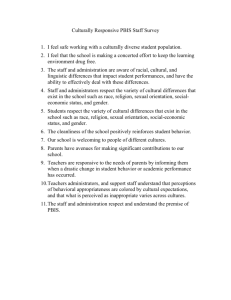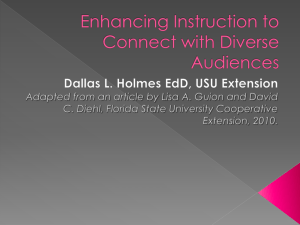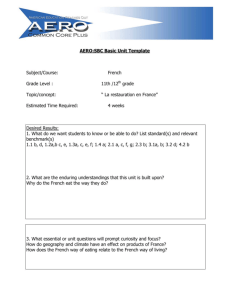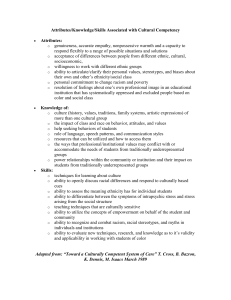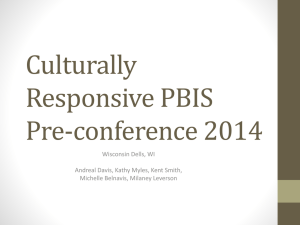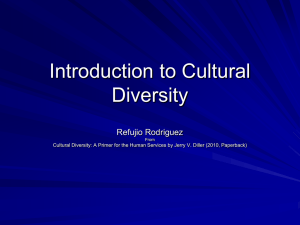Culturally Responsive PBIS
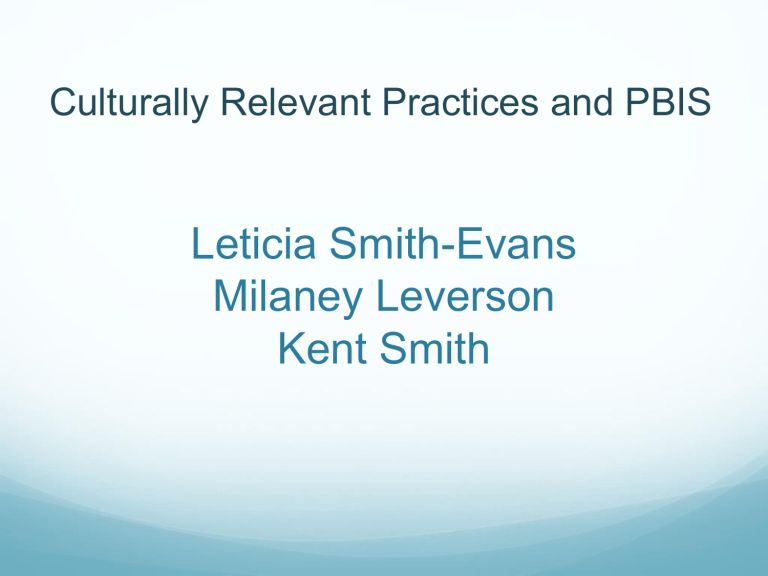
Culturally Relevant Practices and PBIS
Leticia Smith-Evans
Milaney Leverson
Kent Smith
Your Presenters
Leticia Smith-Evans; NAACP Legal Defense Fund
lsevans@naacpldf.org
Milaney Leverson; Eau Claire Area School District
mleverson@ecasd.k12.wi.us
Kent Smith; WI PBIS Network, Eau Claire Area School
District
smithk@wisconsinpbisnetwork.org
Defining our TLAs, ASAP
ODR – Office
Discipline Referral
OSS – Out of
School Suspension
SES – Socioeconomic Status
CRT – Culturally
Relevant Teaching
Cultural Capital –
Ways of behaving, talking, interacting valued by dominant society
Culture – similar language, beliefs, norms, values, behaviors and material objects held by a unique group of people.
What is Culturally Responsive
Practice?
Congruent behaviors, attitudes and policies that come together
In a system, agency or among professionals
To work effectively in cross-cultural situations
The capacity to function effectively in cultural contexts that differ from your own
Awareness of your culture and the influence it has on those around you
When did segregation end?
(Skiba, et al, 2011)
Brown v. Board of Education
“with all deliberate speed…”
Alexander v. Holmes County Board of Education
“There is no reason why such a wholesale deprivation of constitutional rights should be tolerated another minute.”
*
Why do we talk about this?
National and State Data showing need for CR
Practices
District 1 (~15000)
120,0%
100,0%
80,0%
60,0%
40,0%
20,0%
0,0%
% Enrollment 08-09 Suspension % 08-09 Attendance Rate 08-09 HS Completion
Rate
Black
Hispanic
White
Culturally Relevant Teaching and PBIS
School discipline rates are at their all time highs:
Students are being removed from school at nearly double the rate of the early 1970s.
2006 projections from US Dept. of Education:
3.3 MILLION students suspended at least once each year
109,000 students EXPELLED each year http://ocrdata.ed.gov
More reasons
2006 Projections from US Dep ’ t of Ed.:
African-American students nearly 3 times as likely to be suspended and 3.5 times as likely to be expelled as white peers.
Latino students 1.5 times as likely to be suspended and twice as likely to be expelled as white peers.
http://ocrdata.ed.gov
Common Justifications
It ’ s not race; it ’ s poverty.
These are students from more challenging communities.
There are just a few difficult students who are driving the data.
These are students in under-resourced schools with big class sizes.
Its poor parenting, negative parenting, or parents don ’t value education
This is a result of negative peer culture.
*
Frequent Offenses
White students:
Smoking
Vandalism
Leaving without permission
Obscene language
Objective Offenses
African-American students:
Disrespect
Excessive noise
Threat
Loitering
Subjective Offenses
Conclusions and Implications
(as posed by Skiba, et al, 2011)
Disproportionality begins at referral
Administrative consequences appear to be distributed rationally in general
But when disaggregated, see significant disproportionality
African American and Latino students are more likely to receive harsher punishment for same ODR than white students
WHAT DO WE DO ABOUT IT?
But first a quick game…
1.
What do we know about the Hmong culture?
2.
About Native American cultures?
3.
About Middle Eastern cultures?
4.
What about white culture?
Understand the context
Stereotyping & unconscious bias
Cultural disconnect
Misperceived actions on the part of both students and educators
Lack of proper professional development in culturally responsive teaching, de-escalation, etc.
WE STILL CAN’T TALK ABOUT RACE!
However…
Things we were taught in the past such as:
Not talking about race
Not SEEING color (“my classroom is colorblind”)
Not talking about differences
Not being aware of what the practitioner’s background brings to the class
Not attending to the presence and role of whiteness
…ALL contribute to the problem
PBIS addresses School Wide Behaviors, but does not impact the classroom level systems without direct instruction.
Development of Universal supports for behavior lay foundation for Academic supports that take place in the same setting.
Culturally Relevant Instruction is not only best practice but essential to the success of ALL students.
Is one part of reducing disproportionate representation in discipline data
A THREE TIERED APPROACH
*
UNIVERSAL LEVEL
Embedding Culturally Relevant Teaching practices in
Classroom and School-wide expectations and instruction
Frequent Review of Data
Examine practice and challenge the status quo
At the Universal level, some preteaching…
EVERY person has a cultural and racial identity
Staff MUST respond actively & positively to changing social, economic and cultural patterns
Behavioral standards are tied to the dominant culture
Behavioral interventions that are culturally responsive are more effective
IT IS ESSENTIAL TO TEACH the “cultural capital” needed to succeed
And…
Teachers intend the best for their students
Cultural mismatches MUST be examined before selecting a behavior intervention as they can lead to inappropriate behavior
Behavior occurs in a context
the relationship between the student, teacher, peers, classroom, instruction and material
It is easy to misinterpret or misread behavior
Parent and family involvement is CRUCIAL for success
Setting the stage at Universal
Guiding Questions Linked to Classroom
Systems and Universal School-wide Systems
Practitioner Culture:
What cultural expectations do you bring to the educational setting?
What is your culture in relation to education, interactions and school?
(values, beliefs, traditions, customs, worldview, conversational styles, non-verbal language and parenting styles)
What are the historic experiences/implications of your culture?
What are the differences/dissonances between your culture and the student ’ s?
Are you expecting one-way accommodation from the student for any cultural differences? Why?
What accommodations are you expecting?
Student ’ s Culture:
What cultural expectations does the student bring to the educational setting?
What is the student ’ s culture in relation to education, interactions and school?
(values, beliefs, traditions, customs, worldview, conversational styles, non-verbal language and parenting styles)
What are the historic experiences/implications of the student ’ s culture?
What are the cultural characteristics of this student that are strengths in the educational environment?
What have you determined to be motivating & reinforcing to this student?
What are the parents ’ /caretakers ’ view on the student ’ s behaviors of concern?
Classroom Instruction:
What is the teaching style, materials, content, structure, etc?
How are your methods of instruction designed to meet the cultural strengths & learning styles of the student?
How have you explicitly taught this student the “ cultural capital ” needed to succeed in school?
How do you elicit high expectations for this student?
How have you clearly demonstrated & explained to this student expected behavioral responses?
How do you include this student ’ s interests & background in your instruction?
The Classroom Context/Ecology:
What is the cultural environment of the individual classroom based on identified best practices?
How is your classroom based on collaboration
& cooperation rather than competition?
How is your classroom based on praise & reinforcement rather than punishment?
How does your classroom environment allow for movement & interaction?
How does your classroom environment honor student strengths, including this student?
Good Teachers
Teach students - not a subject or grade level.
Maximize academic learning time.
Have students earning their own achievement.
Keep students actively engaged in learning.
High quality and rigorous instruction and high expectations for ALL students.
Good Teachers
Clearly state positive expectations.
Create a climate of positive expectations for all.
Establish effective management techniques.
DATA, DATA, DATA
*
The BIG 5 + 2
Recall your Tier I training to, at each team meeting, review the Big 5 and look for patterns
Even deeper data analysis means to disaggregate data
By subgroups: race, sped status, SES
Review for patterns DOES NOT mean quick a fix
Screening Tools
A measure should be used for students who are
“internalizers”
No externalizing behaviors to show up in ODR data, but teachers have concerns
Such tools should be systemic in use as well as researched with regards to cultural bias.
Screening data is considered along with Big 5 + 2 and
ODR data on student for pattern
Parent/Family Involvement
This is essential at the beginning, but even more so as need for intervention increases.
Schools must value families and whatever level of support they have to offer.
Script/consent process
Vital at entrance to Tier II intervention for the family to understand HOW the intervention works as well as their role in the intervention
Culturally Relevant Practice Checklist
(Initially referred to as Mismatch Checklist)
Brief interview between school and family
Gauges family PERCEPTION of mismatch
Geared to gather the family’s perspective on:
Student/school relationship
Student/classroom relationship
Behavior concerns
Checklist continued…
Provides starting point for discussions based on degree of mismatch
Then utilize the guiding questions to determine how to enhance practice
Becomes paramount as a student moves into higher tier interventions and wraparound is considered
Enhances partnership and communication
Family involvement should increase as need increases
Functional Behavioral Assessment (FBA) helps us understand WHAT the student is getting from the behavior.
Need family perception:
Why the behavior continues
What the student gets from the behavior
FBA is about changing our system to modify student behavior. Perception is vital.
Wraparound
Teams members selected by the family
Include natural supports, not just school staff
Team should reflect family values based on their perceptions of what is important to them and respecting their natural supports
Progress on goals is based on measures of perception and data (ODR, DPR, attendance, grades, etc.)
ACTIVITY
In next slide, consider the information presented.
How do you address this information with staff?
How do you start creating change based on this one piece of information?
*
Take 7 minutes to do this.
Culturally Relevant Practices in PBIS…
…is emerging. There is no “best practice”… YET
Research shows that CRT practices must be a part of a system to be lasting.
Resources
smithk@wisconsinpbisnetwork.org
mleverson@ecasd.k12.wi.us
Suspended Education
www.splcenter.org/getinformed/publications/suspended-education
APA Zero Tolerance Report
www.apa.org/ed/cpse/zttfreport.pdf
PBIS Indiana
www.indiana.edu/~pbisin
Credits
http://www.naacpldf.org
Guiding Questions: Lisa Bardon, PhD. University of
Wisconsin – Stevens Point
Cultural checklist: Eau Claire Area School District adapted from University of Wisconsin – Green Bay
